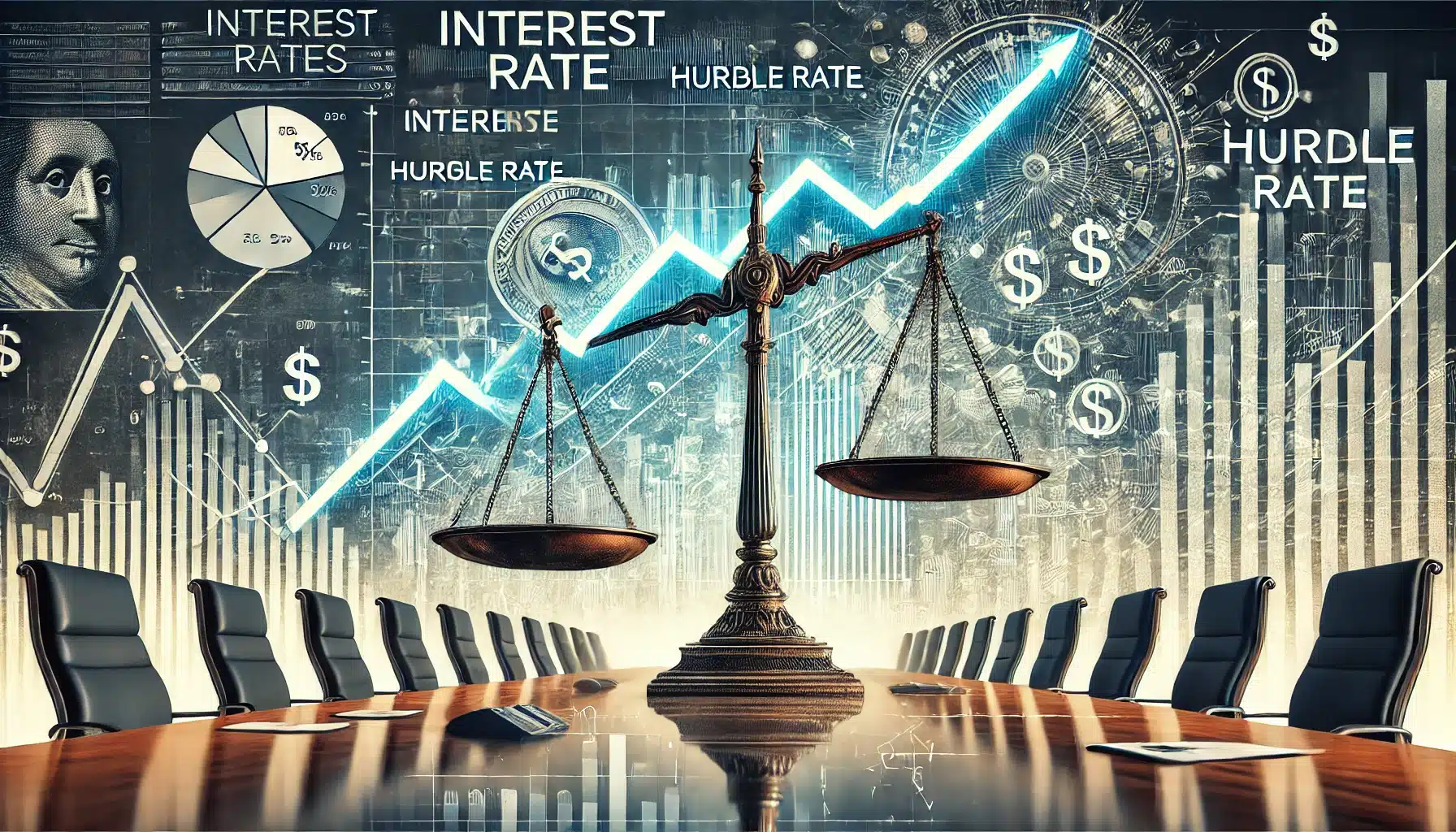How do interest rates affect the Hurdle Rate?

The hurdle rate is the minimum rate of return that an investor or a company requires before deciding to move forward with a particular investment or project. It acts as a benchmark that helps determine whether the potential returns justify the risk and effort involved in the investment. If the expected return on a project or investment is higher than the hurdle rate, the project is typically considered worthwhile. Conversely, if the expected return falls short of the hurdle rate, the investment may be rejected.
This rate is closely tied to the cost of capital, which is the combined cost of debt and equity used to finance the investment. Essentially, the hurdle rate must at least equal the cost of capital to ensure that the company can meet its financial obligations while generating value for its shareholders. The hurdle rate often incorporates a risk premium, reflecting the risk associated with the investment. For higher-risk projects, the hurdle rate is set higher to ensure the potential returns compensate for the uncertainty.
In practical terms, the hurdle rate is frequently used in capital budgeting. When evaluating a potential project, the company calculates its internal rate of return (IRR), which is the expected percentage return on the investment. If the IRR exceeds the hurdle rate, the project is likely to be approved. On the other hand, if the IRR is below the hurdle rate, the project is considered less attractive.
The hurdle rate also reflects opportunity cost, representing the returns that could be earned from alternative investments. By setting a minimum acceptable return, companies ensure that their resources are allocated to the most efficient and profitable projects. For example, if a company’s hurdle rate is set at 12%, only projects with expected returns exceeding 12% will be pursued, ensuring that the investment aligns with the company’s financial goals and risk tolerance.
Interest rates have a direct and significant impact on the hurdle rate because they influence the cost of capital, which is a key component in determining the hurdle rate. When interest rates rise, the cost of borrowing increases, making debt financing more expensive. This higher cost of debt raises the overall cost of capital for a company, which in turn pushes the hurdle rate higher. Companies must then demand a greater return on investments to ensure they can cover the increased expense of financing and still generate value.
Conversely, when interest rates fall, the cost of borrowing decreases, making debt cheaper. This reduces the overall cost of capital and, as a result, lowers the hurdle rate. In such an environment, companies can afford to accept projects or investments with relatively lower expected returns because their financing costs are more manageable.
Interest rates also affect equity financing, as lower interest rates often lead to higher stock valuations and reduced expected returns on equity investments. This can further influence the hurdle rate, especially in cases where equity constitutes a significant portion of a company’s capital structure. Higher interest rates typically result in more conservative investment decisions because only projects with higher returns can clear the elevated hurdle rate, whereas lower interest rates encourage more investment activity by reducing the threshold for acceptable returns.
Shielding hurdle rates from fluctuations in interest rates requires strategic planning and financial discipline to ensure that investment decisions are not overly influenced by external economic conditions. One effective way to achieve this is by setting hurdle rates based on long-term financial goals and historical performance metrics rather than reacting to short-term movements in interest rates. This approach allows companies to maintain consistency in evaluating investments, ensuring that their criteria for success remain stable and aligned with their strategic priorities. By focusing on internal benchmarks, such as the desired rate of return or profitability thresholds, companies reduce their dependence on volatile market conditions.
A balanced capital structure is another critical element in shielding hurdle rates. Companies can achieve this by maintaining a mix of fixed-rate debt and equity financing. Fixed-rate debt is particularly advantageous in this context because its cost remains stable even when interest rates rise or fall, providing predictability in the company’s cost of capital calculations. Equity financing, though not directly tied to interest rates, can also provide stability, especially if the company’s equity is valued consistently over time. By diversifying their funding sources and managing debt-to-equity ratios, firms can mitigate the impact of interest rate fluctuations on their overall cost of capital.
Additionally, some companies choose to base their hurdle rates on internal criteria rather than market-driven factors. For instance, they might set a fixed hurdle rate aligned with their historical return on investment or the profit margins necessary to sustain operations and meet shareholder expectations. This approach allows the hurdle rate to reflect the company’s operational realities rather than external financial pressures. By prioritizing internal metrics, businesses ensure their investment evaluations remain focused on what is most important to their long-term success.
Long-term planning and robust financial forecasting also play a vital role in shielding hurdle rates from interest rate volatility. Companies can model various economic scenarios, including changes in interest rates, to establish hurdle rates that are resilient to short-term fluctuations. For example, they may analyze historical trends and future projections to determine a rate that balances risk and return under both favorable and adverse conditions. This type of scenario planning helps businesses prepare for a range of outcomes and maintain a consistent investment evaluation framework.
Ultimately, shielding hurdle rates from interest rate fluctuations involves a combination of strategic decision-making, financial flexibility, and a focus on internal objectives. By decoupling hurdle rates from external economic conditions, companies can ensure that their investment decisions are driven by long-term goals, sustainable performance metrics, and a stable risk management framework, rather than the unpredictability of market-driven interest rate changes. This stability enhances the company’s ability to evaluate and pursue investments with confidence, even in an uncertain economic environment

Staff
Writer
